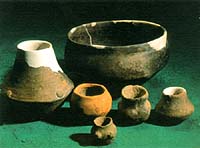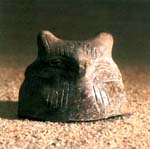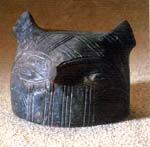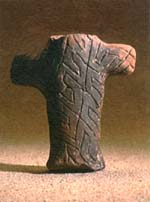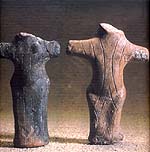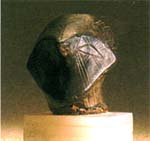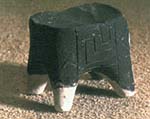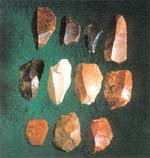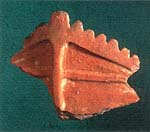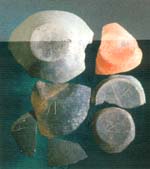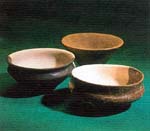


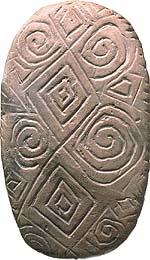 |
| Ritual
bread with carved ornament, Potporanj - Kremenjak, The Late Neolithic, the Vinca
culture |
The Prehistoric Department
Collections of the Stone Age
In The Prehistoric Department of The National Museum, VrÜac, the collections of the Stone Age - classified according to the localities or to the types of objects - represent different collections of very heterogeneous material and content. When we talk about variety of these collections, first of all we must take into consideration longer period of time of about twenty millenniums, i.e. since upper Paleolithic till the end of Neolithic. In this period the essential changes occurred in the way of life of the first inhabitants and its vicinity, therefore the collections of the Stone Age preserved at the museum reflect at the same time a part of different aspect of life of prehistoric populations on our soil.
Dominant raw material for making everyday implements represents primarily stone and later pottery i.e. baked clay. Beside already mentioned materials we also come across very rare samples, such as - obsidian - volcanic glass - or the objects made of spondilus shells used as jewelry or amulets. Ritual objects of baked clay take major part in the collections from all researched sites and minor part is related to handy work made of stone.
The beginning of the creation of the collections of the Stone Age is related to Edward Ritinger, passionate admirer and collector of antics, whose collection was brought into the museum in 1894. Felix Milleker gave to the museum smaller archeological collection and he was the one who also extended the fonds of the museum as custodian through his research work, terrain work, purchase and gifts. In the period after the Second World War, as the custodian of the museum Rastko RaÜajski organized several archeological excavations that Milliker only pointed at. The work of Rastko RaÜajski is first of all reflected in the creation of a huge collection of the Paleolithic material from few sites in the vicinity of VrÜac, on the slopes and at the foot of VrÜac hill. The collection of the Paleolithic material from the sites of At and Crvenka in the northern site of VrÜac hill makes clearly distinguished and characteristic flint tools of the Orinacian culture. Lathes are mentioned in the first place. They can be of different shapes formed by various techniques of hacking, and they are determined by their appearance, type and angle of retouch on a distant end. Cutting hackers are usually without retouch, sometimes with Pseudo-Orinacian retouch, and the most characteristic blades are with Orinacian retouch, which means that the retouch is complete and scales-like type.
Chisels are typical for its single or multifunctional hacking for getting the small blades for engraving. Special knives are also present in this collection retouched by deep or invasive retouch. Their function is similar to knives. Beside characteristic tools the collection contains a great number of gists and splinters. There are more than 5000 items in the Paleolithic collection. It was partly created during Milliker in the 19th century, but it reached its climax by the work of Rastko RaÜajski in the second half of the 20th century. By research work in 1984 in three geological layers only 19 artifacts were found.
The Older Neolithic - The StarĶevo culture - in the collections of the museum in VrÜac is represented with the objects from several sites. If we wanted to draw a parallel between each site we would be able to see the obvious difference in the ceramic material, while the hacked stone material (blades, lathes etc.) is very uniformed. Only scarce finds of tools made of mountain crystal can be distinguished here and a few pieces of obsidian tools were found at the site of Kozluk on the northern slope of VrÜac hill. Polished stone tools of the StarĶevo culture are also unique for we are talking about the tools of the same function (axes, hoes and ploughshares). A small polished tool is distinguished by the trace of perforation together with the long fine chisel. There are no traces of use on the objects which were found at the site of Kozluk. The situation is completely different with the pottery. For example, while at the site of Kozluk the pottery is monochromatic, red baked or dyed, and the ornaments are made by pinching or nail scratching, at the site of At Barbotin brown ceramics is represented, with rough surface, and there are only a few fragments of red dyed pottery with geometric ornaments in black colour. These differences are of chronological importance, i.e. material from Kozluk belongs to the beginning of settling down of agricultural population in the vicinity of VrÜac and at At the inhabitants belong to the beginning of disintegration of the StarĶevo culture. The collections of the Older Neolithic are partly creating during the working days of Felix Milliker, while Rastko RaÜajski expanded these collections with the archeological excavations and recognition.
The Younger Neolithic - The VinĶa culture - is the most widespread culture of Banat and central Banat. VrÜac and its vicinity are full of the remains of settlements from this period of the Stone Age. It is quite safe to say that this culture set the foundations of modern agriculture and other branches of economy. The collections from this epoch are also related to the flint tools, and only at the site of At there were about 16000 pieces of them. In Potporanj, at the site of Kremenjak their number is much larger and it varies both in types and raw materials. In Potporanj the most precious collection of chipped tools represent the collection of about 5000 pieces of obsidian tools and gists. At the same locality were found the objects made of spondilus shells which have about 35 decorative objects.
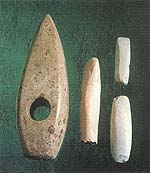 | |
| Chipped
stone tools and hackings, VrÜac - Crvenka, The Early Paleolithic, the Orignacien
culture | Stone
axes from different sites from the vicinity of VrÜac, The Late Neolithic, the
Vinca culture |
Ceramic material of the VinĶa culture preserved in the Museum in VrÜac we can divide into a few groups according to the function and therefore the surface. Pots, jars and pithos used for keeping grained food belong to the group of ordinary kitchen vessels made of clay with the rough surface. Fine pottery is made of very refined clay which could also be used in everyday life. But the ornaments on some of them were sometimes cut in lines and shallow grooved motives together with appearance of specially isolated signs, from simple to the most complicated ones, so that it speaks in favour of the fact that we are dealing with very specific forms. Decoration, conical and biconical forms of ceramic vessels no matter to the surface is very characteristic for all sites of the VinĶa culture in the vicinity of VrÜac. There are 241 objects with cut in signs in the collection. Curiosity from the At site represent fragments of models of the house with preserved architectural elements. Although they are fragmentary, these objects contribute to better acquitance and understanding of appearance and the way of building of real housing objects or holy places in The Neolithic.
 | |
| Altar
model, Potporanj - Kremenjak, The Late Neolithic, the Vinca culture |
The fragment
of a model of house, VrÜac - At The Late Neolithic, the Vinca culture |
Cult objects made of baked clay represent a special category of ritual objects used in different cult operations. Their number and diversity is the most prominent at the Potporanj site of the VinĶa culture. Anthropomorphic statues and statues of animals, amulets, altars, amphorae with prosopomorphic lids and ritual breads surpass the number of 1000 samples, so they belong to the richest collection of cult objects discovered during the period of 120 years of the existence of the Museum.


